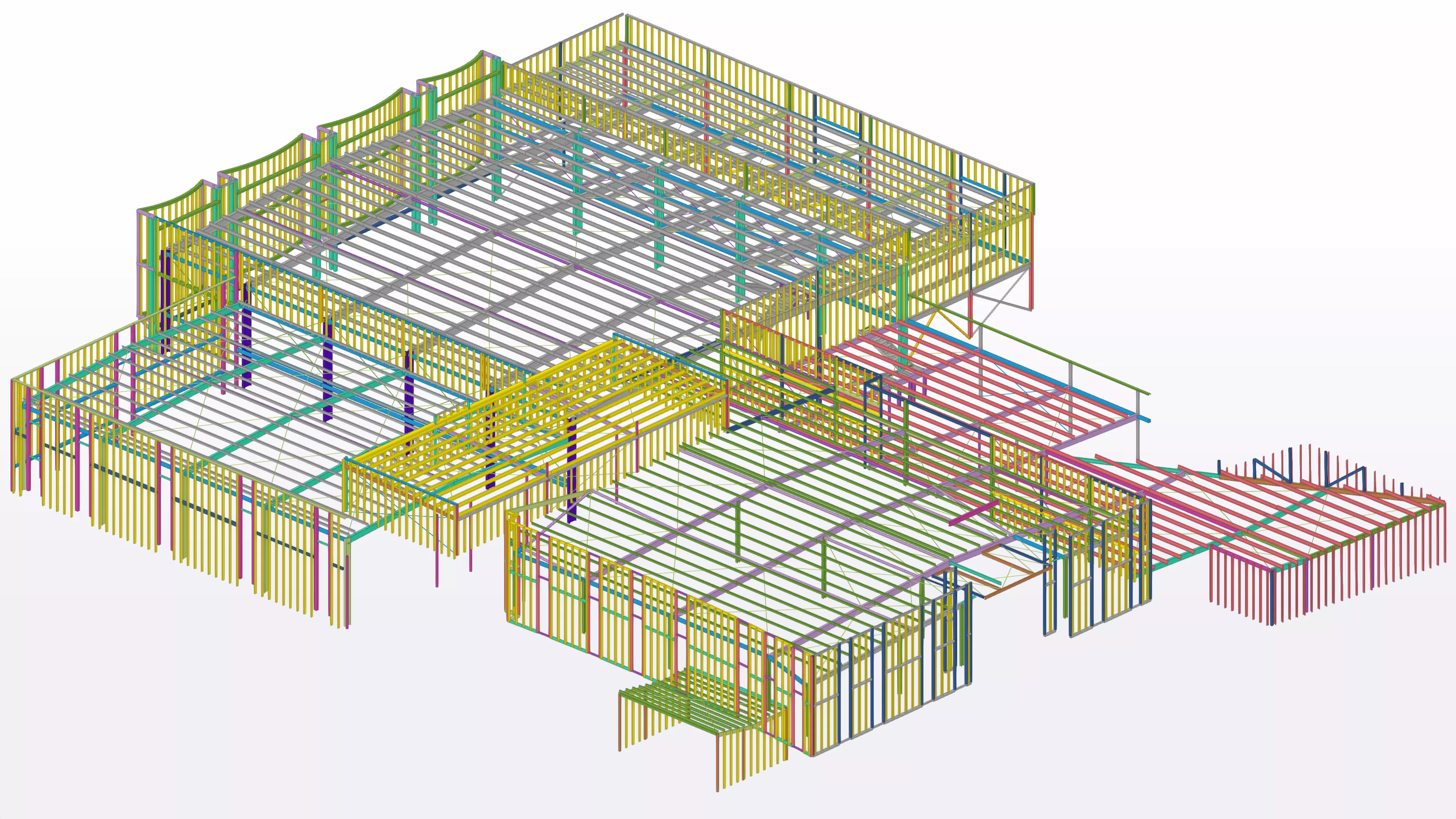Understanding the Building Information Model (BIM): A Primer for 2025/2026 | Hadeed Engineering

Explore the core components of a BIM building model and how it streamlines construction projects from start to finish.
As infrastructure demands grow, so does the need for better coordination between design, engineering, and site execution. Building Information Modeling (BIM) addresses this need by providing a digital environment that enables teams to plan, visualize, and manage every aspect of a project before any construction begins.
In this blog, Hadeed Engineering explores what BIM is, its core components, and how it supports each phase of project delivery. We’ll also share how our team applies BIM to real infrastructure projects to improve accuracy, reduce rework, and accelerate delivery.
What is a Building Information Model (BIM)?
A building information model is a digital, data-rich representation of a facility’s physical and functional characteristics.
Each element in the model, whether it’s a steel beam, HVAC duct, or access ladder, carries embedded information (e.g., material specifications, fire ratings, manufacturer details, etc). This integration of geometry and data transforms BIM into a shared knowledge center that enables architects, engineers, contractors, and facility managers to collaborate effectively throughout the project lifecycle.
Unlike traditional 2D workflows, which rely on fragmented drawings and manual updates, BIM combines geometry, schedules, costs, and sustainability metrics into a single coordinated environment. This eliminates common pain points such as design clashes and inefficient site logistics.
BIM also supports analysis and decision-making. Teams can detect clashes between systems, simulate construction sequencing, and forecast costs in real-time. This multi-disciplinary coordination reduces errors, compresses timelines, and supports more predictable outcomes.
The Core Components of BIM
BIM is a multi-dimensional dataset structured to support decision-making and accuracy in every phase of a project. According to ISO 19650, BIM consists of seven interlocking layers, each building on the last to prevent downstream compromises.
I. 3D Geometry and Data Attributes
At the foundation of BIM lies parametric 3D geometry. Unlike static CAD models, parametric modeling creates intelligent objects: beams, columns, walls, and MEP systems. Each object carries embedded rules and relationships, and adjusting one element automatically updates dependent components, ensuring design consistency and reducing manual coordination errors.
These objects are enriched with data attributes such as material specifications, fire ratings, manufacturer IDs, and maintenance intervals. This integration of objects with data transforms BIM into a live database that allows teams to perform automated analyses and compliance checks directly within the digital environment.
II. Common Data Environment (CDE) and Clash Detection
A Common Data Environment serves as the centralized repository for all BIM-related information. It manages models, drawings, schedules, and metadata in a secure and controlled space accessible to all project stakeholders.
Clash Detection tools are systems integrated into the BIM software to identify spatial conflicts early. Examples of such issues include ductwork intersecting structural steel or insufficient clearances for access ladders. These tools use discipline-specific filters and tolerance thresholds that help design teams resolve issues before they reach the site.
III. 4D, 5D, and Beyond
BIM’s higher dimensions extend its value into project planning, cost control, and facility management:
- 4D (Time): Links tasks and locations to the model to simulate the sequence of activities across a project timeline.
- 5D (Cost): Combines quantity take-offs, unit pricing, and material rates to produce real-time budget forecasts
- 6D (Sustainability): Embeds energy performance metrics, carbon footprint tracking, and renewable energy inputs to support environmentally responsible design.
- 7D (Facility Management): Integrates asset maintenance schedules, equipment specifications, and warranty details to enable predictive maintenance.
Why Adopt BIM for Your Next Project?
1. Improved Coordination and Reduced Rework
BIM creates a single, shared model where architects, engineers, and contractors can collaborate in real time. This minimizes errors caused by fragmented workflows and reduces costly rework during construction. According to industry studies, BIM adoption has resulted in up to 40–50% fewer change orders and a significant reduction in RFIs (Requests for Information), thanks to proactive clash detection and coordinated design.
2. Accelerated Schedules and Efficient Planning
By linking schedules to model elements (4D BIM), teams can simulate construction sequences and optimize site logistics before work begins. This foresight helps avoid scheduling conflicts and streamlines resource allocation. Research highlights that 4D BIM can help save 10-15% in project delivery time, particularly on complex infrastructure works.
3. Better Cost Control and Budget Predictability
5D BIM integrates cost data into the model, enabling dynamic quantity take-offs and real-time budget updates. This visibility supports early value engineering and reduces financial surprises. BIM-enabled workflows can achieve cost savings of 15–30% compared to traditional CAD methods.
4. Productivity Gains & Prefabrication
Project data shows that BIM adoption enhances productivity in labor scheduling by up to 50% and increases pre-fabrication opportunities by up to 50%. This reduces material waste, speeds assembly, and boosts overall site efficiency.
BIM in Action: Hadeed Engineering’s Project Delivery
At Hadeed Engineering, Building Information Modeling is a core part of delivering complex infrastructure projects with precision and efficiency. Our approach integrates 3D modeling, data-driven coordination, and fabrication-ready detailing to ensure seamless transitions in every stage of a construction project, from initial concept design to final handover.
I. Concept and Detailed Design
In the early stages of projects, Hadeed Engineering prepares 3D models and shop drawings that capture key structural and metal work elements. For the South Geelong to Waurn Ponds Duplication, our deliverables included gantries, access ladders, walkways, and guardrails.
Similarly, in the Edison International Academy project in Doha, Hadeed Engineering worked under a tight deadline to optimize designs and produce detailed shop drawings for 133 tonnes of structural steel, successfully supporting the school’s opening timeline.
II. Pre-Construction and Fabrication
Hadeed Engineering’s 3D models and shop drawings are used during pre-construction to enable precise fabrication planning. In the Princes Freeway Interchanges Upgrade, our scope covered gantries, barrier rails, and aluminum screens.
For the Lithocraft Canopy Extension, the team provided detailed shop drawings for 24 tonnes of structural steel, identifying design challenges early and helping the project progress without delays.
III. Site Execution and Handover
During site execution, Hadeed Engineering’s outputs supply the technical specifications needed for accurate assembly. In the West Gate Tunnel Project, our 3D models and shop drawings supported the installation of 2,750 tonnes of structural steel, including gantry stairs and barrier rails for the elevated roadway.
The Whitten Oval Stage 2 Redevelopment similarly relied on Hadeed’s shop drawings for 27 tonnes of balustrades and handrails, contributing to the transformation of a major sporting venue.
Common Challenges in BIM Adoption & How to Overcome Them
1. Fragmented Supply Chains
In projects involving multiple contractors and suppliers, maintaining a unified BIM workflow can be difficult. Disparate software systems and inconsistent data protocols often lead to version conflicts and incomplete models.
Solution: Establish a Common Data Environment (CDE) that acts as the single source of truth for all stakeholders. Align workflows with recognized standards like ISO 19650 to ensure consistency in data exchange and model management. This centralization reduces versioning errors, improves collaboration, and keeps information secure and accessible throughout the project lifecycle.
2. Resistance to Workflow Change
Transitioning from traditional 2D drawings to a fully integrated BIM process requires a cultural shift. Teams accustomed to legacy methods may hesitate to adopt new tools and practices.
Solution: Build stakeholder confidence through early engagement and clear communication of BIM’s value. Implement pilot projects or phased rollouts to demonstrate tangible benefits. Providing targeted training for project teams ensures smoother transitions and encourages a wider adoption of BIM across disciplines.
3. Unclear Standards and LOD Targets
Without clearly defined standards and Level of Development (LOD) milestones, BIM deliverables can vary in quality and usefulness. This ambiguity can delay approvals and create gaps during the handover process.
Solution: Define LOD requirements at key stages of the project (LOD 300 for design coordination and LOD 500 for as-built models) and document them in a BIM Execution Plan (BEP). Following standards like ISO 19650 helps maintain consistency and ensures that models are data-rich and reliable for downstream uses, including facility management.
Hadeed Engineering: Your Trusted Partner in BIM Delivery
At Hadeed Engineering, Building Information Modeling is our foundation for precision, efficiency, and successful project outcomes. Our team delivers end-to-end BIM services, from parametric 3D modeling and clash detection to fabrication-ready shop drawings and coordinated data environments.
Ready to streamline your next project with BIM expertise you can rely on?
Contact us today to discuss how Hadeed Engineering can support your goals.



